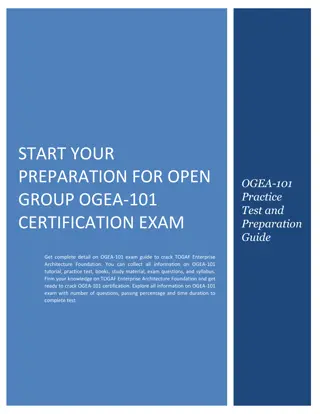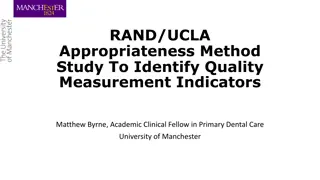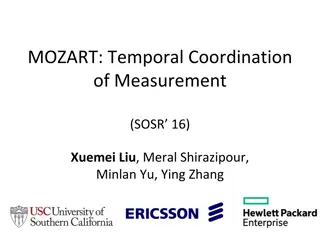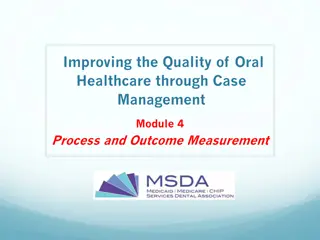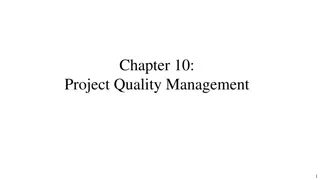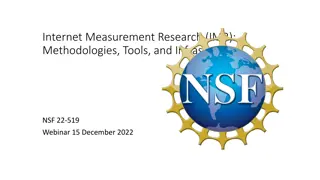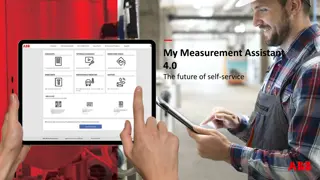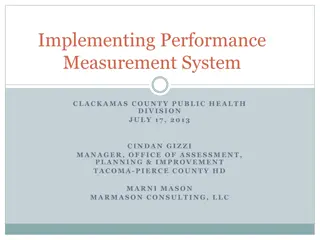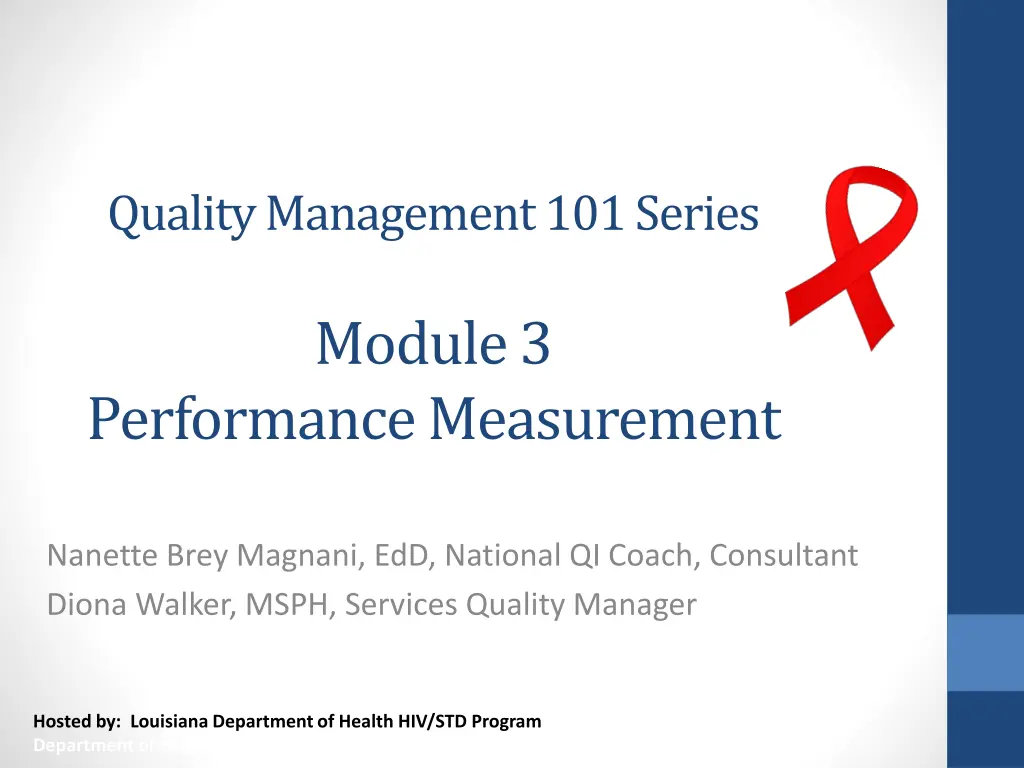
Principles of Performance Measurement and Quality Improvement in Healthcare Programs
Learn about the importance of balancing performance measurement with quality improvement initiatives in healthcare programs. Discover key principles, avoidable pitfalls, and essential resources for building a culture of quality improvement in HIV/STD programs.
Download Presentation

Please find below an Image/Link to download the presentation.
The content on the website is provided AS IS for your information and personal use only. It may not be sold, licensed, or shared on other websites without obtaining consent from the author. If you encounter any issues during the download, it is possible that the publisher has removed the file from their server.
You are allowed to download the files provided on this website for personal or commercial use, subject to the condition that they are used lawfully. All files are the property of their respective owners.
The content on the website is provided AS IS for your information and personal use only. It may not be sold, licensed, or shared on other websites without obtaining consent from the author.
E N D
Presentation Transcript
Quality Management 101 Series Module 3 Performance Measurement Nanette Brey Magnani, EdD, National QI Coach, Consultant Diona Walker, MSPH, Services Quality Manager Hosted by: Louisiana Department of Health HIV/STD Program ste Louisiana Department of Health-STD/HIV Program
First Things, First In the chat room, write: 1.Your Name 2.Your Role
Purpose Expand QI culture in HIV/STD programs in Louisiana by building the capacity of leaders and staff to improve HIV+ and at risk patient care and providing basic QI information in chunks that could be used for: Staff Orientation QM Plan Program Assessment and Evaluation
QM 101 Series Module 1: Overview - Quality Improvement April 11, 2018; 12:00 pm 1:00 pm Module 2: Quality Program Infrastructure May 9, 2018; 12:00 pm 1:00 pm Module 3: Performance Measurement June 6, 2018; 12:00 pm 1:00 pm Module 4: QI Project Steps and PDSA July 11, 2018; 12:00 pm 1:00 pm
Session 2 Review Reviewed HRSA/HAB grant requirements PCN#15-02 for QM Program infrastructure Continued to develop a common knowledge and framework of QI Principles and QI terms Focus: Defining your Quality Accountability System; QM Plan - Table of Contents; QMC/QI Project Team R/R
Principle: Balance between Performance Measurement and QI Initiatives Infrastructure
What We Want to Avoid.. Quality Management Program
https://careacttarget.org/cqii Center for Quality Improvement and Innovation Review NQC (CQII) tutorials before June webinar: Quality Academy C. Measurement and Data 7. Acting on Measurement Overview (Beginner) 8. Choosing Performance Data (Intermediate) 9. Collecting Performance Data (intermediate) 21. Statistics 101 and Making Graphs in Microsoft Excel (Intermediate) 25. Introduction to the HAB measures (Intermediate) 26. Using the HAB measures (intermediate) Review HRSA/HAB HIV Performance Measures HRSA HIV/AIDS Bureau (HAB) September 2017 Performance measures to help Ryan White HIV/AIDS programs monitor and improve the quality of care they deliver. Resource updated on 03/15/2018 Resources Resources formerly found on the on the NQC website have been transferred to the Clinical Quality Management webpage of this site.
Session 3 Outcomes Understand importance of performance measurement and its relationship to goal achievement Understand defining elements and types of performance measures (PM) Understand how to report data for QMC and QI Projects to guide improvement work
Why Measure? It s very simple: You can t improve what you can t measure!
What is a Quality Measure? A quality measure is a tool to assess specific aspects of care and services that are linked to better health outcomes while being consistent with current professional knowledge and meeting client needs.
Most Pressing Performance Measurement Question What are you struggling with the most as it relates to performance measurement?
Performance Measures that Matter Selection of Portfolio 1. Know your funders expectations RW Quality Management PCN #15-02: Components of an Effective CQM Program Infrastructure Performance measurement based on funded services Quality Improvement
Purpose Use of data and measurable outcomes to determine improvements to achieve specific aims based on health outcomes.
What is a Performance Measurement System? a regular process of collecting, analyzing and reporting data regarding patient care, health outcomes on an individual or population level, and patient satisfaction, for example, Annual RW HIV/AIDS Service Report (RSR) Health disparities across different target populations Quarterly data collection on CQM Performance Measures (PM) All funded service categories need at least one PM Highly utilized and prioritized service categories should select two
Elements of a Quality Management Plan 1. Quality statement 2. Quality improvement infrastructure, including participation of stakeholders, roles/responsibilities 3. Performance measurement and Results 4. Annual quality goals 5. Capacity-building for quality improvement 6. Communication plan 7. Evaluation 8. Work plan (action plan)
Performance Measures that Matter Selection contd 2. Align your measures with your program and agency goals Patient care health outcomes Epidemiology data - community Continuum of Care ending the epidemic
Measures to Evaluate Mission/Purpose Progress Our mission is to develop and maintain a network-wide quality program that improves patient health outcomes for those individuals living with HIV. The vision is to become trend-setters in quality health care initiatives and family centered care. What are possible measures that might be selected to achieve this vision?
Potential Measures for Improvement Focus Patient outcome measures Mortality Viral Load Suppression (HAB, National HIV/AIDS Strategy- NHAS) Process measures Gap- in-Care (visits); on ARV medication (HAB, NHAS) New patients linked to care Results are in the trendsetter class Benchmark with best clinics in the state Top 10 percentile nationally ( RW state reports)
Types of Measures Outcomes The end result The effect on the individual or the population Processes The actions taken to produce the outcome The procedures for achieving the best outcomes What is an Indicator?
Quiz Look at the data report on the next slide Which measure(s) are also public health measures Outcome measures Process measures
GOCARE QI Performance Measures for 2017-2018 Apr 17 May 17 Jun 17 Jul 17 Aug 17 Sep 17 Oct 17 Nov 17 Dec 17 Jan 18 Feb 18 Mar 18 Viral Load Suppression 76%78%76%81%81%83%83%83%83%86%86%87% Cervical Cancer Screening Oral Health Exam Syphilis Screening 22% 22%29%35%38%52%55%65%68%69%60%61% 20%16%13%16%18%18%19%19%20% 22%25%26% 73%80%82%84%86%88%88%89%89%86%84%84%
Quiz contd Look at the data report on the prior slide Which could be an Outcome measure(s) for Cervical Cancer Sreening? Syphilis Screening? Process measure(s) for Viral Load Suppression?
Relevant Processes Include Medical care Case management Cross agency coordination Clinic, program or hospital management What is an Indicator?
Types of Data Commonly Used In HIV QI Data Type Characteristics From the same root word as quantity Based on measureable information Example Laboratory test values Patient height, weight Number of patients receiving a screening test Number of patients with undetectable viral load Observation of patient flow Client satisfaction surveys Focus groups Key informant interviews Quantita- tive From the same root word as quality Descriptive information Observed but not measure Qualitative
What Makes a Good Measure? Relevance Does the measure affect a lot of people or programs? Does the measure have a great impact on the programs or patients/clients in your substance use program? Measurability Can we realistically and efficiently use the measure(s) given finite resources? Selecting Indicators
What Makes a Good Measure? (cont.) Accuracy Is the measure based on accepted guidelines or developed through formal group-decision making methods? Improvability Can the performance rate associated with the measure realistically be improved given the limitations of your services and population? Selecting Indicators
Common HIV-Related Measures Aspect of HIV Care Quality of Care Measure HIV Monitoring Viral Load tests performed at least once/year Antiretroviral therapy Adherence assessment every 4 months TB screening Annual PPD testing Prophylaxis of opportunistic infections PCP prophylaxis Gynecologic care Annual pelvic exam Substance use Annual substance use assessment Coordination of care Annual dental exam
Measures Should Be Clearly Defined This definition includes: Who is eligible to be evaluated? What part of this population should have received the care being measured? (Who should be counted in the denominator?) What part of those who should have received the care did receive the recommended care? (Who should be counted in the numerator?) Defining Indicators
Eligible Patients/Sample How to think about measures Denominator Number of active patients with at least one HIV medical visit in 2017 Numerator Number of patients in the denominator with an HIV viral load test <200 copies/ml at last HIV viral load test during the measurement year 33
Example: Viral Suppression Measure by HRSA/HAB Percentage of patients, regardless of age, with a diagnosis of HIV with a HIV viral load less than 200 copies/ml at last HIV viral load test during the measurement year Numerator: Number of patients in the denominator with a HIV viral load less than 200 copies/mL at last HIV viral load test during the measurement year Denominator: Number of patients, regardless of age, with a diagnosis of HIV with at least one medical visit in the measurement year Patient Exclusions: None Defining Indicators
How Will You Define Who is Eligible to be Evaluated? Location: all sites, or only some? Gender: men, women, or both? NHAS Disparity: MSM of color, women of color, youth, transgender people Age: any limits? Patient conditions: patients who are co-infected Treatment status: suppressed, undetectable Defining Indicators
Range of Performance Measures Available HRSA HIV/AIDS Bureau (HAB) HHS HIV Measures National Quality Forum (NQF) National Quality Center (NQC) In+care Campaign HIVQUAL
HAB Performance Measures www.hab.hrsa.gov/deliverhivaidscare/habperformmeasures.html Clinical (Groups 1-3) Medical Case Management Pediatrics Oral Health ADAP Systems-level
Measure HIV PositivityNumber of HIV positive tests in the 12-month measurement period Number of persons with a diagnosis of Stage 3 HIV infection (AIDS) within 3 months of diagnosis of HIV infection in the 12-month measurement period Linkage to HIV Medical Care 3 months of HIV diagnosis Number of persons with an HIV diagnosis who had at least one HIV medical care visit in each 6 month period of the 24 month measurement period, with a minimum of 60 days between the first medical visit in the prior 6 month period and the last medical visit in the subsequent 6 month period Numerator Denominator Number of HIV tests conducted in the 12-month measurement period Number of persons with an HIV diagnosis in the 12-month measurement period Late HIV Diagnosis Number of persons who attended a routine HIV medical care visit within Number of persons with an HIV diagnosis in 12-month measurement period Number of persons with an HIV diagnosis with at least one HIV medical care visit in the first 6 months of the 24 month measurement period Retention in HIV Medical Care
Measure Antiretroviral Therapy (ART) Among Persons in HIV Medical Care Viral Load Suppression Among Persons in HIV Medical Care Numerator Denominator Number of persons with an HIV diagnosis and who had at least one HIV medical care visit in the 12- month measurement period Number of persons with an HIV diagnosis who are prescribed ART in the 12-month measurement period Number of persons with an HIV diagnosis with a viral load <200 copies/mL at last test in the 12 month measurement period Number of persons with an HIV diagnosis and who had at least one HIV medical care visit in the 12- month measurement period Number of persons with an HIV diagnosis who were homeless or unstably housed in the 12-month measurement period Number of persons with an HIV diagnosis receiving HIV services in the last 12 months Housing Status
HRSA/CDC Found Suitable for NQF Endorsement Medical visit frequency Gap in medical care Prescribed HIV antiretroviral therapy Viral load suppression
Useful at Many Levels of HIV Care To align the work on the different Ryan White Program Parts At the system level At the provider level Within a program s quality management plan
When preparing reports.Remember Who is Your Audience? Quality Management Committee? Front Line Staff? Clinical Staff? Panel? Huddle? Multidisciplinary Team? Board Members? Consumer Advisory Board People in Waiting Room?
Summary HAB does not require Recipients to use their measures but it strongly urges you to use the measures to: Track and trend performance Identify areas for improvement Strengthen quality management plans Benchmark with other RW Programs Questions How could you use the following line graph for: Tracking, trending performance? Identify areas for improvement? Strengthen your QM Plan?? Benchmark with other RW Programs in LA? In US?
Trending Data Use of Line Graphs GO CARE TARGETED PERFORMANCE MEASURES FOR 2017/2018 100.00% 90.00% 80.00% 70.00% 60.00% 50.00% 40.00% 30.00% 20.00% 10.00% 0.00% Apr 17 May 17 Jun 17 Jul 17 Aug 17 Sep 17 Oct 17 Nov 17 Dec 17 Jan 18 Feb 18 Mar 18 Viral Load Suppression Cervical Cancer Screening Oral Health Exam Syphilis Screening
Zufall Viral Load Suppression 180 100 160 95 140 Number of Patients(#) 120 Percentage (%) 90 100 80 85 60 40 80 20 0 75 Report Date Patients Suppressed Total Patients Percentage Linear (Percentage)
On To the Next QI 101 Webinar Using data to identify areas for improvement Making improvement: QI Project Steps and PDSA
Quick Check-in Q & A Comments Any Aha moments? What went well? What could be improved?
QI Training/Learning Resources NQC Tutorials: www.nationalqualitycenter.org It will take you to careacttarget.org Center for Quality Improvement and Innovation, scroll down to Resources and click on Clinical Quality Management webpage Series of QI learning modules - Making Improvement Tutorials 10. Narrowing Your Focus Using Data to Select an Improvement Project intermediate 11. Using Teams to Improve Quality (intermediate) 12. How to get Started with Quality Improvement Teams (beginner) 13. PDSA Cycle or How We Accelerate Improvements in Care? (beginner) 14. Useful Quality Improvement Tools (Beginner) 15. Ideas for Change in HIV Care (Intermediate) Ideas: Brown bag lunch learning group; pre-work. Other?
Next Steps Tell us your challenges in improving care Let us know who wants to volunteer to present with us for the Quality Improvement webinar Sign up for TA through Diona if you want TA on Developing QM Plans Infrastructure Staff QI training



